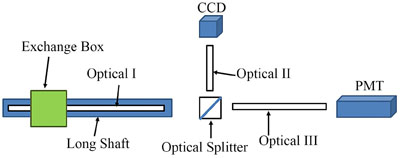Kewen WANG, Juan HUANG, Jiafeng CHANG, Ruijie ZHOU. Simulation analysis of fast electron response of ZnS(Ag) scintillator in EAST[J]. NUCLEAR TECHNIQUES, 2024, 47(5): 050003
Search by keywords or author
- NUCLEAR TECHNIQUES
- Vol. 47, Issue 5, 050003 (2024)

Fig. 1. Diagram of FILD system layout

Fig. 2. Diagram of scintillator probe
Fig. 3. (a) Change in brightness of the scintillator luminescence image captured using the CCD camera of shot 113 598; (b) Changes in Ip, Ne, IU1, FILD01, NF3, and RA1 in 2~5 s of shot 113 598; (c) Energy count of lost runaway electrons in 2~5 s of shot 113 598
Fig. 4. Model of stainless steel and ZnS(Ag) coating established in Geant4
Fig. 5. Relationship between incident electron energy and number of luminescent photons of the scintillator without a magnetic field under vertical incidence
Fig. 6. Logarithmic coordinate axis of 0~4 MeV
Fig. 7. Energy response curve of the scintillator to electrons
Fig. 8. Simulated luminescence curves of electrons divided into two energy segments, after passing through the stainless steel, multiplied by different weights according to Fig.6
Fig. 9. Relationship between scintillation proportion of secondary particles and incident electron energy
Fig. 10. Effect of thickness of ZnS(Ag) coating on luminescence under vertical incidence
Fig. 11. Variation in number of luminescent photons with incident angle at different incident energies
Fig. 12. Relationship between number of scintillation photons and incident energy at different magnetic field values (color online)
Fig. 13. Relationship between number of scintillation photons and incident energy at different magnetic field angles (color online)
Fig. 14. Relationship between number of scintillation photons and incident energy at different pitch angles (color online)
Fig. 15. Relationship between number of photons and pitch angle for different incident energies (color online)
|
Table 1. Components of 316L stainless steel

Set citation alerts for the article
Please enter your email address



